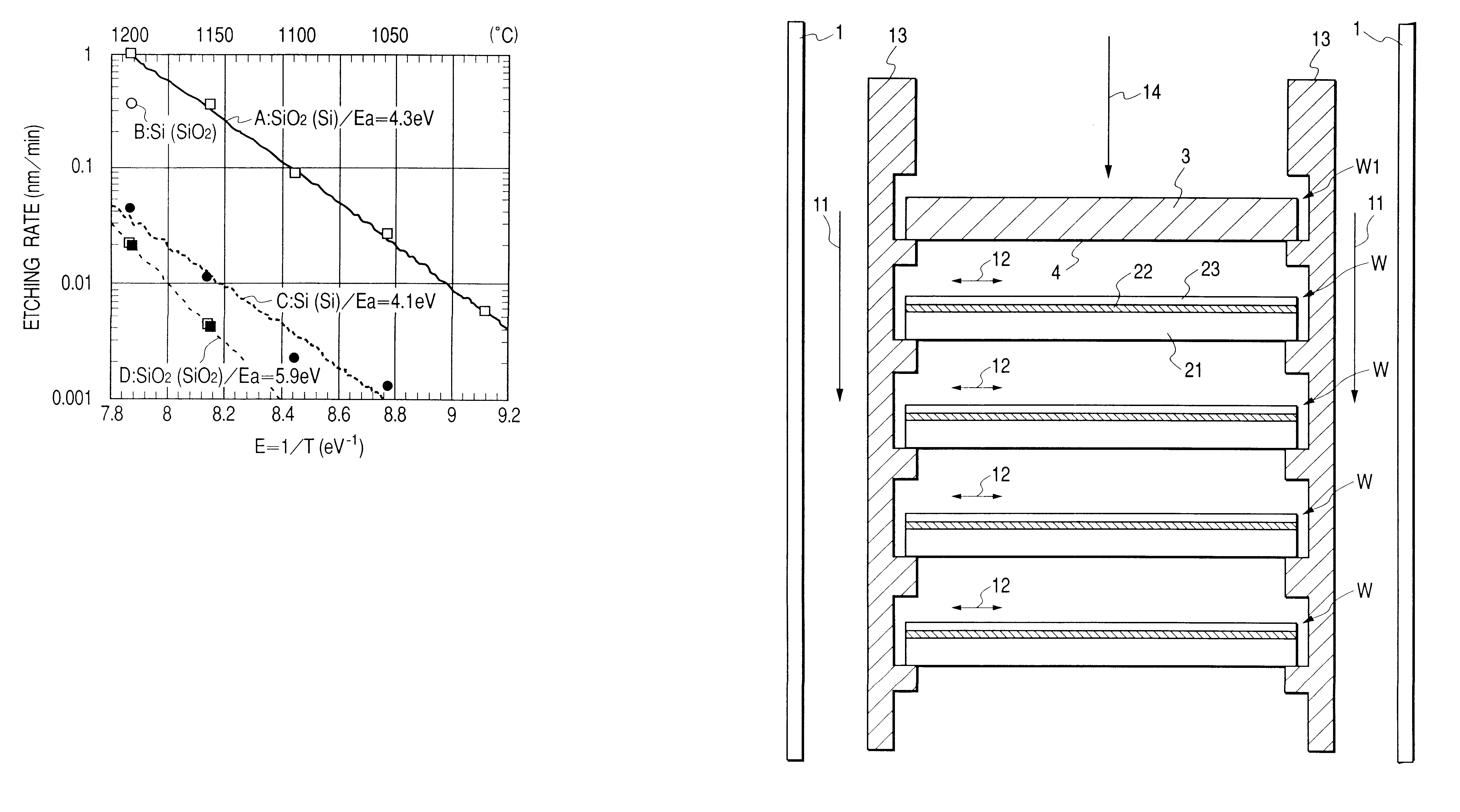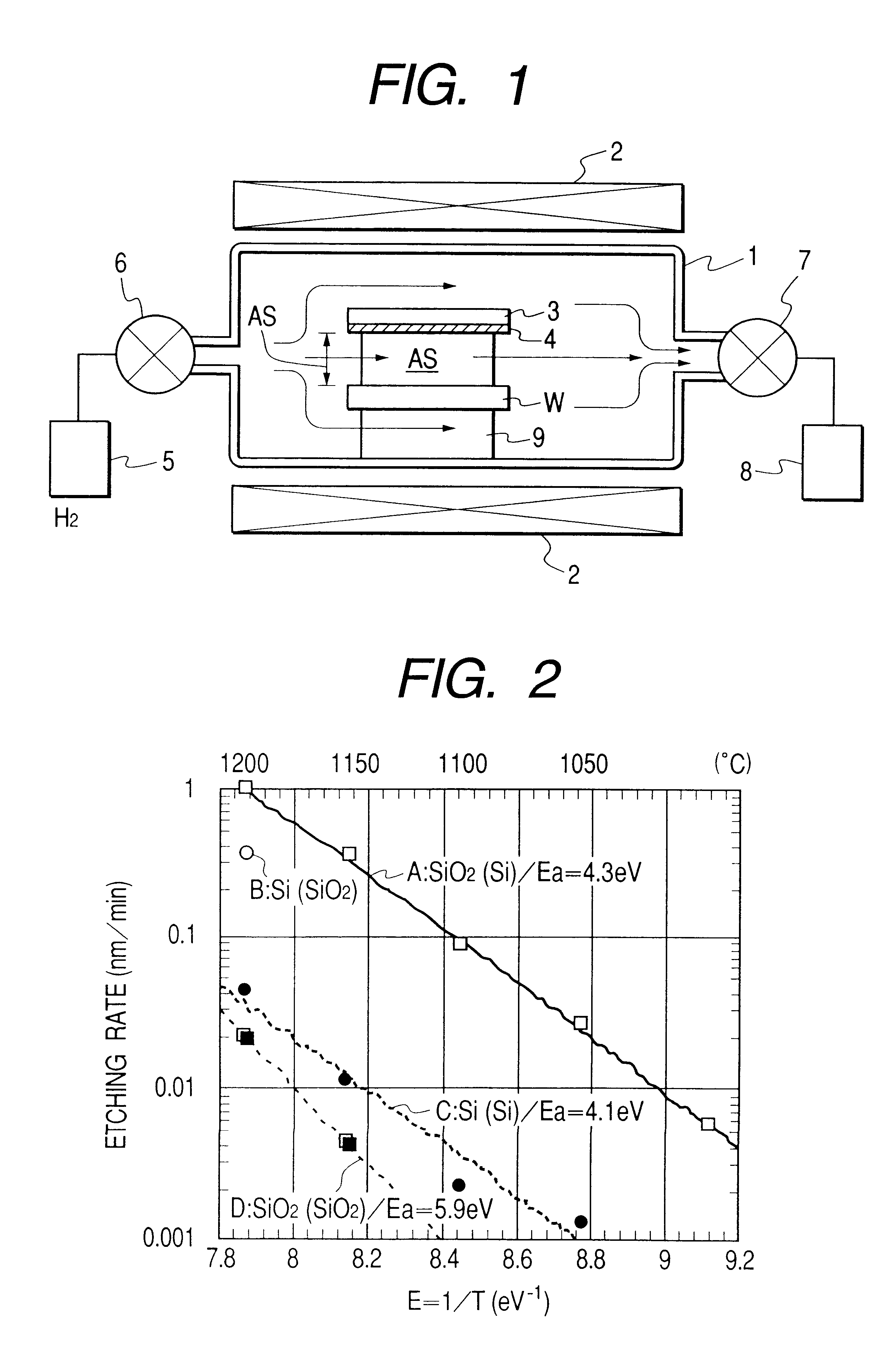Method and apparatus for heat-treating an SOI substrate and method of preparing an SOI substrate by using the same
a technology of soi substrate and heat treatment method, which is applied in the direction of lighting and heating apparatus, furnaces, etc., can solve the problems of reducing the uniformity of film thickness, difficult to keep the extent of polishing constant, and inability to reduce the concentration of boron
- Summary
- Abstract
- Description
- Claims
- Application Information
AI Technical Summary
Benefits of technology
Problems solved by technology
Method used
Image
Examples
example 2
layer transfer / vertical furnace / various boats / oxide film rear surface
For each specimen, the surface of an 8-inch boron-doped Si wafer having a specific resistance of 0.017 .OMEGA.cm and a (100) orientation was anodized in a solution containing 49% HF and ethyl alcohol mixed in a ratio of 2:1 to produce a 10 .mu.m thick porous silicon layer on the wafer surface. The silicon wafer was then heat-treated at 400.degree. C. in an oxygen atmosphere for 1 hour and subsequently dipped into a 1.25% HF aqueous solution for 30 seconds to remove the very thin oxide film formed on and near the surface of the porous silicon layer. The silicon wafer was then washed well with water and dried. Thereafter, the silicon wafer was placed in an epitaxial growth system and heat-treated at 1,100.degree. C. in a hydrogen atmosphere by adding silane gas at a very small rate to close almost all the pores on the surface of the porous silicon. Then, a single crystal silicon film was formed on the porous silicon ...
example 3
layer transfer / vertical furnace / quartz tray
For each specimen, the surface of an 8-inch boron-doped Si wafer having a specific resistance of 0.017 .OMEGA.cm and a (100) orientation was anodized in a solution containing 49% HF and ethyl alcohol mixed in a ratio of 2:1 to produce a 10 .mu.m thick porous silicon layer on the wafer surface. The silicon wafer was then heat-treated at 400.degree. C. in an oxygen atmosphere for 1 hour and subsequently dipped into a 1.25% HF aqueous solution for 30 seconds to remove the very thin oxide film formed on and near the surface of the porous silicon layer. The silicon wafer was then washed well with water and dried. Thereafter, the silicon wafer was placed in an epitaxial growth system and heat-treated at 1,100.degree. C. in a hydrogen atmosphere to close almost all the pores on the surface of the porous silicon. Then, a single crystal silicon film was formed on the porous silicon to an average thickness of 310 nm.+-.5 nm by adding dichlorosilane a...
example 4
tion / epitaxial layer transfer
For each specimen, the surface of an 8-inch boron-doped Si wafer having a specific resistance of 0.017 .OMEGA.cm and a (100) orientation was anodized in a solution containing 49% HF and ethyl alcohol mixed in a ratio of 2:1 to produce a 6 .mu.m thick porous silicon layer on the wafer surface. To be more accurate, the porous silicon layer included a 1 .mu.m thick highly porous layer having a porosity of about 60% and a 5 .mu.m thick less porous layer having a porosity of 20% located on the highly porous layer, which layers were produced by varying the electric current. The silicon wafer was then heat-treated at 400.degree. C. in an oxygen atmosphere for 1 hour and subsequently dipped into a 1.25% HF aqueous solution for 30 seconds to remove the very thin oxide film formed on the surface of the less porous layer and the wall surfaces of the pores located near that surface. The silicon wafer was then washed well with water and dried. Thereafter, the silicon...
PUM
| Property | Measurement | Unit |
|---|---|---|
| surface roughness | aaaaa | aaaaa |
| thickness | aaaaa | aaaaa |
| dew point | aaaaa | aaaaa |
Abstract
Description
Claims
Application Information
 Login to View More
Login to View More - R&D
- Intellectual Property
- Life Sciences
- Materials
- Tech Scout
- Unparalleled Data Quality
- Higher Quality Content
- 60% Fewer Hallucinations
Browse by: Latest US Patents, China's latest patents, Technical Efficacy Thesaurus, Application Domain, Technology Topic, Popular Technical Reports.
© 2025 PatSnap. All rights reserved.Legal|Privacy policy|Modern Slavery Act Transparency Statement|Sitemap|About US| Contact US: help@patsnap.com



